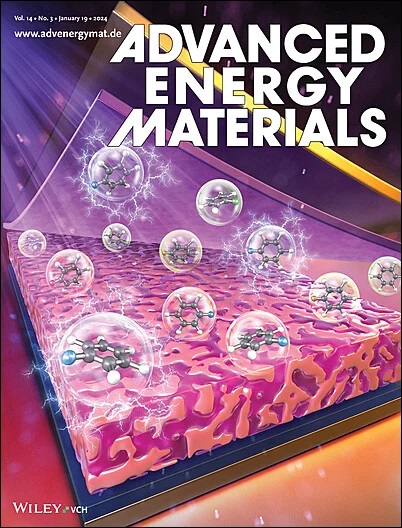Modeling-Guided Design of Semitransparent Organic Photovoltaics with Improved Energy Harvesting and Saving Capabilities
IF 26
1区 材料科学
Q1 CHEMISTRY, PHYSICAL
引用次数: 0
Abstract
Integrating semitransparent organic photovoltaics (ST-OPVs) into building structures is a promising technology that serves aesthetic purposes while retaining window functionality, and it also facilitates solar energy harvesting and heat insulation. However, balancing power conversion efficiency (PCE), visible light transmittance (VLT), infrared radiation rejection (IRR), and color rendering index (CRI) for window applications remains a significant challenge. In this study, ST-OPVs are developed that feature innovative near-infrared-absorbing materials. These devices are further coupled with an optical layer optimized through high-throughput optical modeling to fine-tune and enhance the different properties of the ST-OPVs. Specifically, ST-OPVs are achieved with a VLT of over 30%, a PCE of 12.5%, an IRR of over 90%, and a CRI of over 80. Furthermore, higher PCE of over 14% and IRR of over 95% can also be achieved, demonstrating the tunability of these photovoltaic properties. These figures highlight the exceptional performance of specialized ST-OPVs for window applications, demonstrating their dual function of generating electricity and energy saving. Additionally, simulations show that replacing traditional heat insulation films with the ST-OPVs can reduce annual energy demand by up to 60%, using Hong Kong as an example, underscoring their significant potential in sustainable building-integrated photovoltaic (BIPV) applications.

具有改进能量收集和节约能力的半透明有机光伏电池的建模指导设计
将半透明有机光伏(st - opv)集成到建筑结构中是一项很有前途的技术,它在保持窗户功能的同时满足美学目的,并且还有助于太阳能收集和隔热。然而,平衡窗口应用的功率转换效率(PCE)、可见光透过率(VLT)、红外辐射抑制(IRR)和显色指数(CRI)仍然是一个重大挑战。在这项研究中,st - opv的特点是创新的近红外吸收材料。这些器件与通过高通量光学建模优化的光学层进一步耦合,以微调和增强st - opv的不同特性。具体来说,st - opv的VLT超过30%,PCE超过12.5%,IRR超过90%,CRI超过80。此外,PCE可达14%以上,IRR可达95%以上,证明了这些光伏特性的可调性。这些数字突出了专用于窗口应用的st - opv的卓越性能,展示了其发电和节能的双重功能。此外,模拟结果显示,以香港为例,以st - opv取代传统隔热膜可减少高达60%的年能源需求,突显st - opv在可持续建筑集成光伏应用方面的巨大潜力。
本文章由计算机程序翻译,如有差异,请以英文原文为准。
求助全文
约1分钟内获得全文
求助全文
来源期刊

Advanced Energy Materials
CHEMISTRY, PHYSICAL-ENERGY & FUELS
CiteScore
41.90
自引率
4.00%
发文量
889
审稿时长
1.4 months
期刊介绍:
Established in 2011, Advanced Energy Materials is an international, interdisciplinary, English-language journal that focuses on materials used in energy harvesting, conversion, and storage. It is regarded as a top-quality journal alongside Advanced Materials, Advanced Functional Materials, and Small.
With a 2022 Impact Factor of 27.8, Advanced Energy Materials is considered a prime source for the best energy-related research. The journal covers a wide range of topics in energy-related research, including organic and inorganic photovoltaics, batteries and supercapacitors, fuel cells, hydrogen generation and storage, thermoelectrics, water splitting and photocatalysis, solar fuels and thermosolar power, magnetocalorics, and piezoelectronics.
The readership of Advanced Energy Materials includes materials scientists, chemists, physicists, and engineers in both academia and industry. The journal is indexed in various databases and collections, such as Advanced Technologies & Aerospace Database, FIZ Karlsruhe, INSPEC (IET), Science Citation Index Expanded, Technology Collection, and Web of Science, among others.
 求助内容:
求助内容: 应助结果提醒方式:
应助结果提醒方式:


